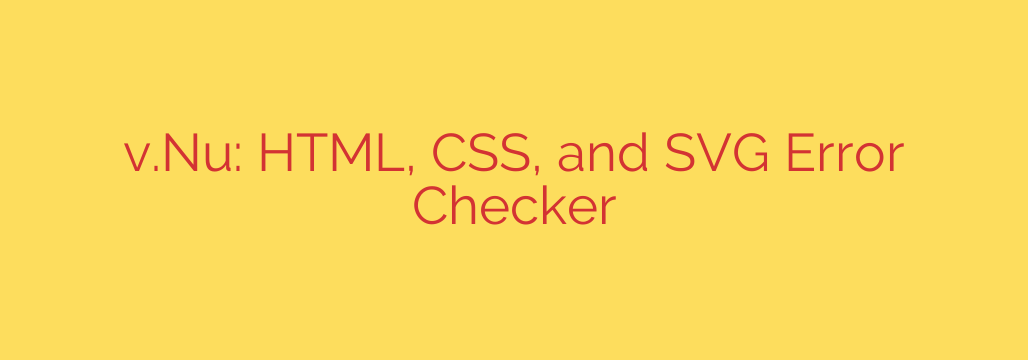
Master Your Code: The Essential Guide to HTML, CSS, and SVG Validation
In web development, what you can’t see can definitely hurt you. Browsers are notoriously forgiving; they work hard to render even poorly written code, often hiding underlying errors. While this seems helpful, it can lead to inconsistent behavior across different browsers, unexpected bugs, and accessibility issues that harm the user experience. The key to building robust, professional, and reliable websites is ensuring your code is clean and valid.
Code validation is the process of checking your source code against the official rules and standards for that language. It’s like a proofreader for your website, catching everything from simple typos to complex structural problems. By validating your code, you ensure your website is built on a solid foundation, making it more predictable, maintainable, and accessible.
The Critical Importance of Clean, Validated Code
Before diving into the “how,” it’s essential to understand “why” validation is a non-negotiable step in any professional development workflow.
- Improved Cross-Browser Compatibility: The single biggest reason to validate your code is to ensure it works as expected everywhere. While one browser might correctly guess what you meant with a missing closing tag, another might render the page completely broken. Valid code behaves predictably across Chrome, Firefox, Safari, and other browsers.
- Enhanced SEO Performance: Search engines like Google prefer well-structured, error-free websites. Clean code is easier for search engine crawlers to parse and index, which can positively impact your rankings. Fewer errors often correlate with better technical SEO.
- Better Accessibility: A valid code structure is the bedrock of web accessibility. Screen readers and other assistive technologies rely on a proper document outline and correctly used tags to interpret content for users with disabilities. Errors like duplicate ID attributes or improper element nesting can make a site unusable for some visitors.
- Easier Debugging and Maintenance: Hunting for a bug in a sea of invalid code is a nightmare. When you know your code is structurally sound, you can eliminate a whole class of potential problems, allowing you to find and fix functional bugs much faster. This also makes it easier for other developers (or your future self) to understand and maintain the codebase.
The Ultimate Tool for Web Standards Compliance
To effectively check your code, you need a powerful and reliable tool. The Nu Html Checker is an open-source validator that serves as the backend for the W3C’s official validation services. It is the gold standard for checking conformance with modern web standards.
This validator is a comprehensive solution capable of checking not just your HTML, but your HTML, CSS, and SVG code all at once. This integrated approach is crucial, as modern web pages are a complex interplay of these three technologies. The checker compares your document against the living standards defined by the WHATWG and W3C, providing detailed feedback on any discrepancies.
How to Validate Your Web Documents
Using a validation tool is a straightforward process. There are typically three primary methods for checking your code, allowing you to integrate it easily into your workflow.
- Validate by URL: This is the easiest method for checking a live website. Simply enter the public URL of the page you want to inspect, and the validator will fetch the page and analyze its source code.
- Validate by File Upload: If you are working on a project locally and it isn’t live on the web yet, you can use this option. Simply upload your HTML file directly from your computer for a complete analysis. This is perfect for pre-deployment checks.
- Validate by Direct Input: For quick tests, snippets, or isolated sections of code, you can copy and paste your code directly into a text area. This is incredibly useful for debugging a specific component without needing to check an entire page.
Actionable Security and Best Practices
While code validation is primarily about quality and standards, it has indirect security benefits. Clean, well-formed code reduces the risk of certain injection attacks and other vulnerabilities that can arise from broken or improperly parsed markup.
To make the most of code validation, follow these best practices:
- Distinguish Between Errors and Warnings: The validator will report two types of issues. Errors are clear violations of the specification and must be fixed. They represent serious problems that will likely cause rendering or functional issues. Warnings are potential problems or deviations from best practices that may not break the page but should be reviewed and addressed.
- Validate Early and Often: Don’t wait until the end of a project to validate your code. Make it a regular habit. Run the validator after completing a major feature or before committing your code to a repository. This prevents errors from piling up and becoming overwhelming.
- Aim for Zero Errors: While some warnings might be acceptable in specific contexts, your goal should always be to eliminate all errors. A document that passes validation with zero errors is a sign of professional, high-quality work.
By integrating a powerful validator into your development process, you move beyond just building websites that “work” and start engineering web experiences that are truly reliable, accessible, and future-proof.
Source: https://www.linuxlinks.com/v-nu-catch-mistakes-html-css-svg/








